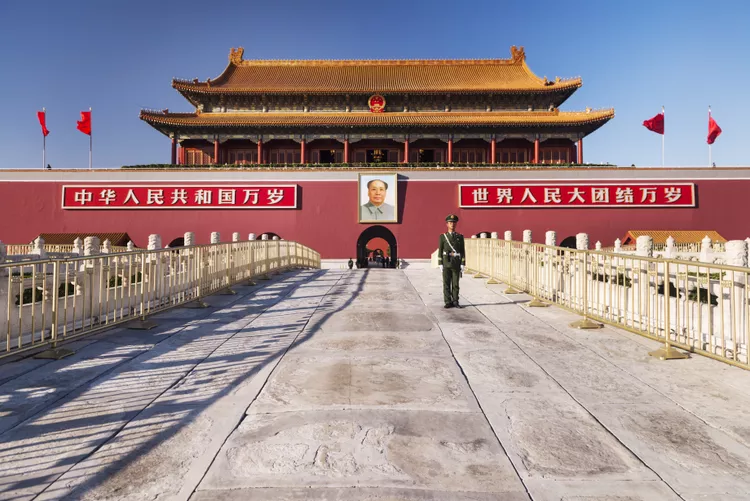Article Summary:
Tiananmen Square in Beijing is unarguably the stone heart of China. Although technically there are three other public squares in China that are larger, Tiananmen is a seemingly endless plain of concrete and monolithic structures meant to showcase the grand scale of the communist party.
The square attracts a multitude of visitors. Even with its impressive 109 acres (440,000 square meters) and capacity of around 600,000 people, it often feels bustling! It can easily reach capacity during significant events such as National Day on October 1.
Wandering around Tiananmen Square will undoubtedly become one of the most memorable experiences from your journey to Beijing.

Orientation
Tiananmen Square is oriented north to south, with the Forbidden City occupying the northern end. The photogenic portrait of Chairman Mao, along with the entrance, make the northern end typically the most crowded.
Chairman Mao’s mausoleum and the Monument to the People’s Heroes are located near the center of Tiananmen Square. The Great Hall of the People is situated in the northwest corner, while both the Museum of the Chinese Revolution and the Museum of Chinese History can be found in the northeast corner.
Despite its massive size, it’s essential to note that Tiananmen Square is not the largest public square in the world as commonly claimed, nor is it the largest in China. Xinghai Square in Dalian holds that title with over 1.1 million square meters — four times the size of Tiananmen Square.
Tip: For stunning photographs, time your visit to coincide with the raising or lowering of the flag at dawn and dusk. The daily sunrise ceremony occurs at the flagpole on the northern end of Tiananmen Square. A sharply dressed color guard and Chairman Mao’s portrait on the entrance of the Forbidden City behind the flag create excellent photographic opportunities. However, arrive early, as the ceremony draws a crowd and lasts only about three minutes!
Guidelines for Visiting Tiananmen Square
- Tiananmen Square is heavily monitored by armed and undercover police. An abundance of cameras are present, and fire extinguisher stations are available for potential emergencies.
- Security Checkpoints: Visitors must pass through security checkpoints, which may involve searches or identification requests. Carry your passport or another form of ID at all times, as your bags may be examined.
- In early June, particularly on June 4, heightened security and tension may be present as people remember the historical events associated with Tiananmen Square. It may be prudent to plan your visit for a different date.
- Dress Appropriately: Avoid clothing with any political messages or themes (e.g., “Free Tibet” shirts). It’s also wise to steer clear of shirts with death or religious themes.
- Be cautious of unscrupulous vendors in tourist-heavy areas. While many interactions with students or locals seeking English practice are harmless, refrain from committing to any food or tea outings to avoid hidden costs.
- Expect to be approached by street hawkers encouraging small purchases. If you buy from one, others may mob you. Respond with a firm “bu yao” (don’t want/need it) and walk away if necessary.
- Western tourists, regardless of numbers, often attract attention while exploring Tiananmen Square. You may hear the term laowai, which is a harmless label for foreigners.
- Tiananmen Square is lit at night and generally safe but closes at midnight. The experience of walking across the less populated square in the evening can feel surreal.
- Bicycles must be walked through Tiananmen Square.

Getting to Tiananmen Square
Tiananmen Square is conveniently located in the heart of Beijing; directional signs in the vicinity guide visitors. Its prominence makes it difficult to overlook!
If your accommodation is beyond walking distance, accessing the square via taxi or subway is straightforward. Although public buses service Tiananmen Square, navigating them may pose challenges for visitors unfamiliar with Mandarin.
Tiananmen Square is accessible via three subway lines:
- Line 1 (red), Beijing’s busiest, allows access to the north end of the square through the Tiananmen East (Xi) and Tiananmen West (Dong) subway stops. Both stops are located on W Chang’an Avenue, with Tiananmen East (Xi) being the closest, just one stop away from the popular tourist district of Wangfujing.
- Line 2 (blue) features one stop (Qianmen Station) at the southern end of Tiananmen Square.
Taxis in Beijing may have limited English-speaking drivers, but they will likely understand your request for Tiananmen. If that fails, simply mention the “Forbidden City” in English.
Tip: Before leaving your hotel, it’s advisable to grab a card containing your hotel’s address for easy returns, and have the staff write your destination in Chinese. This approach simplifies communication with taxi drivers.
The Tiananmen Square Massacre
“Tiananmen” translates to “gate of heavenly peace”; however, it was far from peaceful during the summer of 1989. Millions of protesters, including numerous students and their professors, gathered in the square, questioning the one-party political system in China while advocating for accountability, transparency, and freedom of speech.
Following extensive nationwide protests, a hunger strike, and the declaration of martial law, tensions escalated dramatically on June 3 and 4. Soldiers opened fire on protesters and drove military vehicles into crowds. Official estimates report several hundred deaths; nevertheless, the Tiananmen Square Massacre is regarded as one of history’s most censored events, with actual fatalities likely reaching into the thousands.
Post the “June Fourth Incident,” as it is referred to in China, Western countries responded by imposing economic sanctions and arms embargoes against the People’s Republic of China, while the government tightened media control and censorship. As a result, many popular websites, including YouTube and Wikipedia, remain blocked in China today.





